Fixed Interest
Morgans offers an extensive range of Fixed Interest products and services to help you achieve your investment objectives. Your adviser will help you incorporate fixed interest into your broader wealth management strategy.

Invest for income
Cash management accounts

Cash management accounts
Enjoy the convenience of our at-call cash facilities with competitive interest rates. Our preferred products offer direct bank deposits in your name with reputable Australian banks, providing easy access to your funds. Link your account to your share trading account for seamless settlements and have dividends and interest payments deposited directly. Your adviser will manage paperwork and transactional instructions, relieving you of administrative tasks.

Term deposits
Enhance your returns and build an income portfolio with our term deposit options. Held at reputable financial institutions, term deposits offer fixed terms and higher interest rates compared to at-call accounts. You can benefit from our preferential relationships with leading banks and Authorised Deposit-taking Institutions (ADIs) to find the best term and interest rate for your needs.
Morgans provides foreign currency term deposits with attractive rates for deposits exceeding AU$100,000, and flexible/structured term deposits, allowing you to combine floating and fixed interest rate payments based on your outlook on future interest rate levels.

Listed debt and hybrids
As a major participant in the Australian listed fixed interest securities market, we can offer you advice as well as a range of new investment opportunities from a range of Australia's largest banks and industrial companies.
Listed debt and hybrid investments deliver higher levels of income, paid regularly; some also offer the benefits of franking. Your adviser can build a tailored income portfolio for you, which unlike managed fund alternatives, can be constructed to take into account your specific objectives and risk profile.

Government and corporate bonds
A government bond is a debt obligation of the issuing government, signifying that when you invest in a government bond, you are essentially lending money to the issuing government. As a debt obligation, the issuer is obligated to make all contracted payments. Bonds, being wholesale debt securities, are traded by institutional investors and are not subject to a prospectus.
We offer a comprehensive Government bond investment service, including custody facilities. Bonds improve portfolio diversification and help reduce portfolio risk while providing stable income.

Exchange-traded Government bonds
Exchange-traded bonds on the ASX provide holders with access to bonds issued by the Australian Government providing a low-risk security and diversification for investment portfolios.

News & insights
Superannuation Changes in 2026: What Div296 and PayDay Super Mean for Your Wealth
Key Takeaways
- Div296 overhaul introduces tiered tax rates for super balances above $3M and $10M, starting 1 July 2026.
- PayDay Superannuation law requires employers to pay Super Guarantee within 7 business days of wages.
- Economic outlook for 2026 shows steady growth and opportunities for investors.
- SMSF members must take extra care to meet annual minimum payment requirements to avoid losing the pension exemption.
- Age pensioners have a bit more flexibility without earned income affecting their pension benefits.
Introduction
More superannuation reforms are coming in 2026, which will impact high-balance super holders and employers. The government has revised Div296 policy and the new PayDay Superannuation legislation aims to improve fairness and compliance in Australia’s retirement system. Combined with a shifting economic outlook, these changes make it critical to review your strategy now.
This guide explains what’s changing, why it matters, and how you can prepare.
Div296 Explained: New Rules for High-Balance Super Accounts
From 1 July 2026, the government will implement a tiered tax system for large super balances if legislation is implemented:
What this means for you:
- If your Total Super Balance (TSB) exceeds $3M, a portion of your earnings will attract higher tax.
- SMSF members and defined benefit interests are included.
- The ATO will calculate liabilities, but funds must report realised earnings.
Action steps:
- Clients should hold off taking any action until we know more. There are still many details yet to be clarified with the amended Div296 policy so we ask clients to continue to be patient.. Continue to speak to your adviser, who will keep you updated when further details are released by the government.
PayDay Superannuation: On-Time Employer Contributions Become Law
The Treasury Laws Amendment (PayDay Superannuation) Bill 2025 introduces a major compliance shift:
- Start date: 1 July 2026.
- New rule: Employers must pay Super Guarantee within 7 business days of paying wages (Qualifying Earnings).
- Penalties: Increased fines for late payments.
- Impact: Small businesses may face challenges adapting to real-time reporting. The change in timing of SGC payments in the first year may result in employees exceeding their concessional contribution cap if they are also salary sacrificing into super.
Why it matters:
This change aims to reduce unpaid super and improve retirement outcomes. Employers should ensure they understand this new law by utilising available education tools and resources that are available. Payroll systems will need to be updated and staff educated prior to 1 July commencement date.
Economic Outlook for 2026: What Investors Should Know
Australia’s economy is forecast to improve to 2.3% in 2026, with inflation easing to 3.0%. Key trends include:
- AUD strength: Expected to rise to US70 cents in 2026.
- Commodity recovery: Wheat, corn, and soybeans undervalued, leading to opportunities for agribusiness investors.
- Global stability: Growth is healthy but not spectacular.
Investor takeaway:
Diversification across all asset classes and sectors remains critical.
Practical Steps to Prepare
For Individuals
- Review super contributions strategies to ensure caps won’t be breached, and ensure annual minimum pension payments are made.
- Understand Work Bonus rules if you’re a pensioner and partake casual work.
For SMSF Trustees
- Ensure compliance with updated ATO rulings on income streams and minimum payment standards.
For Employers
- Seek advice on what upgrades need to occur to your payroll systems in preparation for PayDay Super compliance.
Conclusion
Once again, 2026 brings more superannuation changes. Whether you’re an investor, employer, or retiree, proactive planning is essential to protect and grow your wealth.
Ready to prepare?
Speak to a Morgans adviser today for tailored strategies on superannuation, SMSF compliance, and investment planning.
Morgans clients receive exclusive insights such as access to our latest Your Wealth publication.
Contact us today to begin your journey with Morgans.
FAQs
1. What is Div296 and who does it affect?
Div296 applies to individuals with super balances above $3M. It introduces higher tax rates on realised earnings for large balances.
2. When does PayDay Super start?
The law takes effect on 1 July 2026, requiring employers to pay super within 7 business days of wage payment.
3. Will unrealised gains still be taxed?
No. The new system taxes realised gains only, aligning with existing income tax concepts.
4. How can I prepare for these changes?
Some changes such as Div296 are not yet legislated so no action should be taken yet until details are clearer. For PayDay Super changes, employers should review their payroll systems and seek professional advice..
5. Where can I find official guidance?
Visit the ATO website and Treasury fact sheets for detailed updates.
Introduction
Michael Knox, Morgans Chief Economist, shares his latest quarterly outlook on global growth, inflation, commodities, and interest rates. Here are the key takeaways for November 2025.
Global Growth Outlook
Growth is slowing but stabilising across major economies:
- US: Eases to 1.8% in 2025 (including effects of US shutdown), recovering to 2.2% in 2026.
- Euro Area: Improves to 1.2% in 2025.
- China: Slows to 4.8%.
- India: Strong at 6.6%.
- Australia: Firms to 1.9%, inflation at 3.5%.
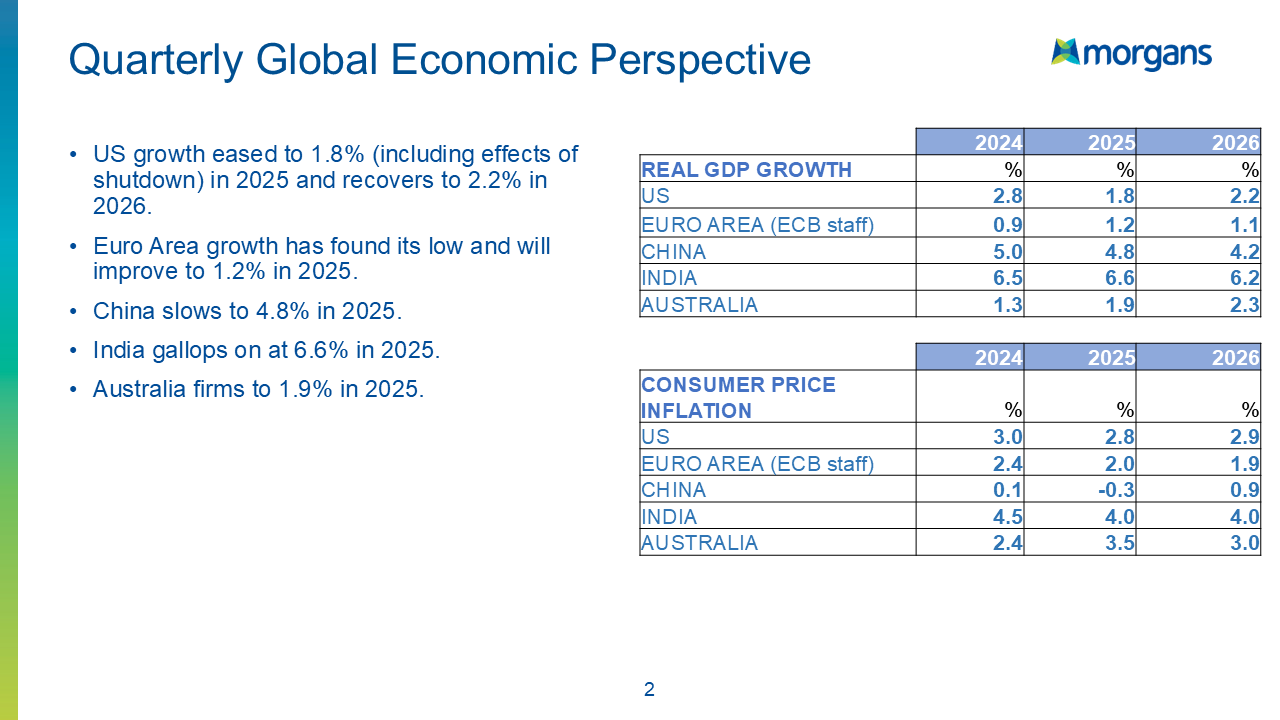
Australia: Inflation & Employment
- Retail electricity prices are rising as subsidies end, adding pressure to inflation.
- Employment growth is soft at 1.5%, below the median of 2.17%.
- Unemployment near 4% suggests inflation around 3.4%, above the RBA target.

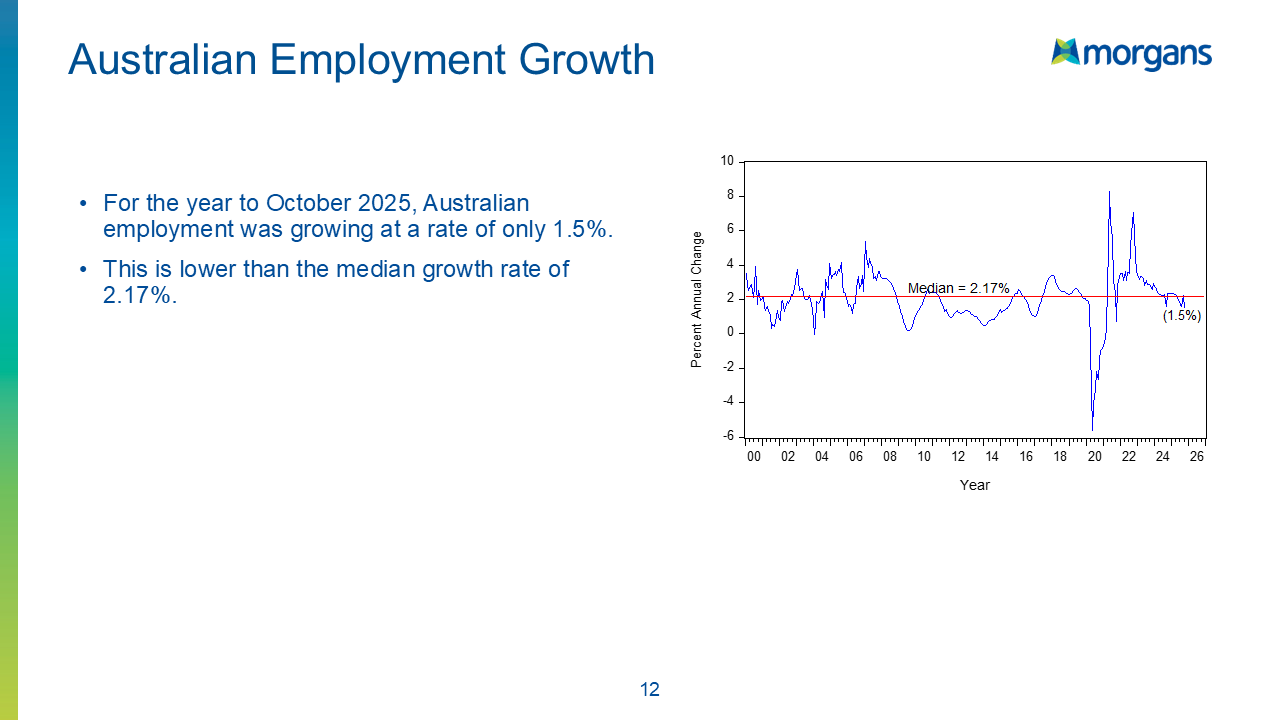
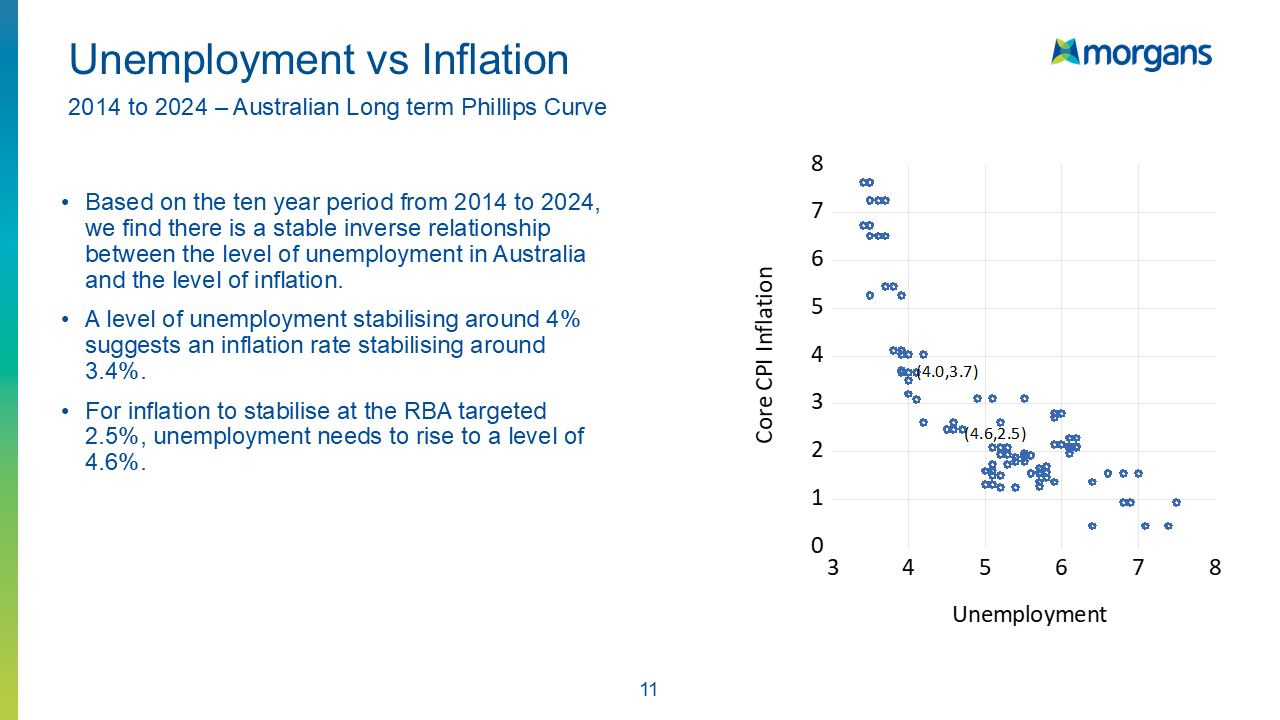
Interest Rates & Monetary Policy
- RBA cash rate expected to rise to 4.1%, driven by higher core inflation.
- In the US, below-trend growth signals potential Fed Funds rate cuts ahead.
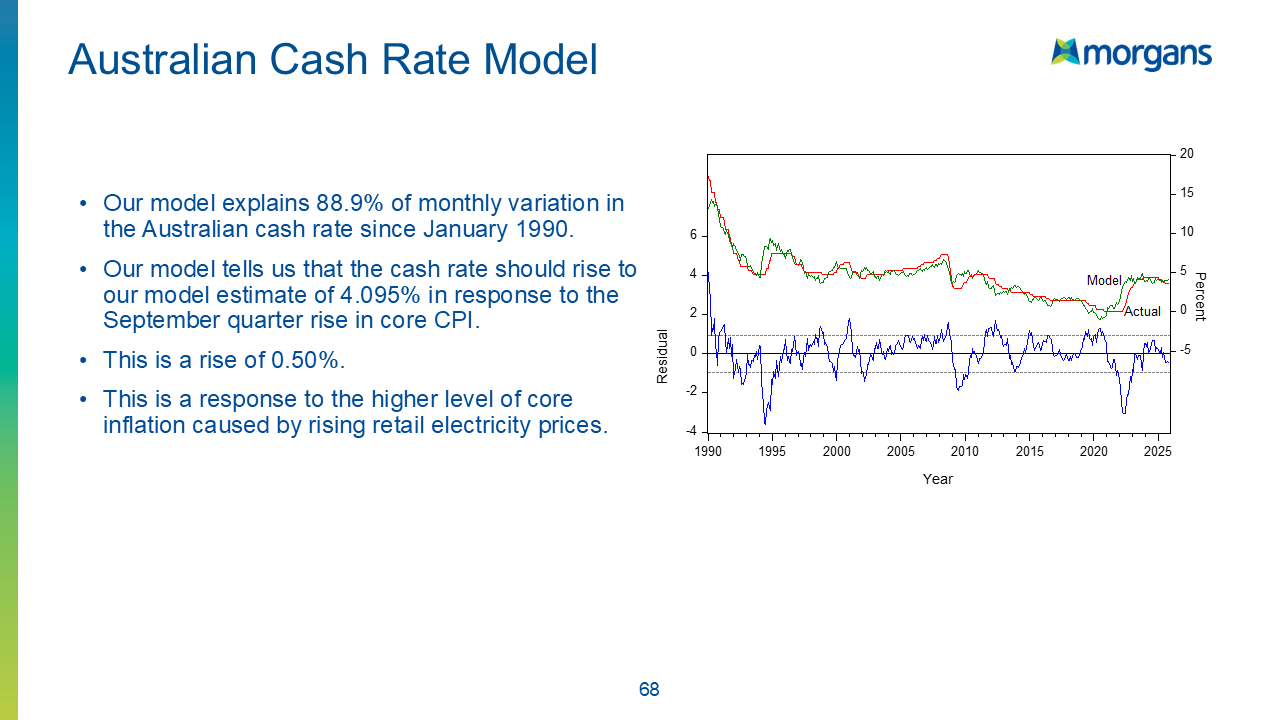

Commodities Snapshot
- Iron Ore: Slightly above fair value at US$100.80.
- Copper: Significantly overvalued at US$10,225 per tonne.
- Nickel & Zinc: Moderately undervalued.
- Gold: At record highs (US$4,013 per ounce) with limited upside.
- Soft Commodities: Wheat and cotton remain undervalued, presenting potential buying opportunities.
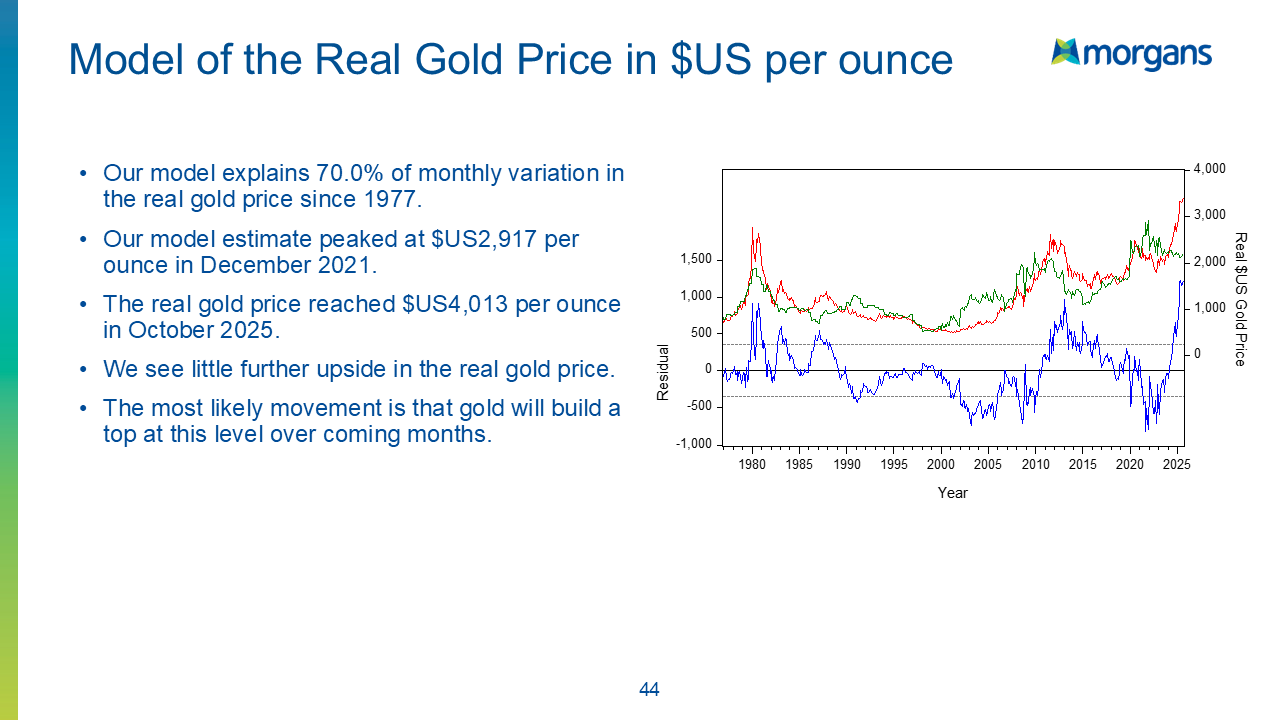
Equities Outlook
- S&P500: Model suggests fair value above current levels, but earnings expected to ease in Q4.
- ASX200: Trading well above model estimates, indicating strong sentiment.

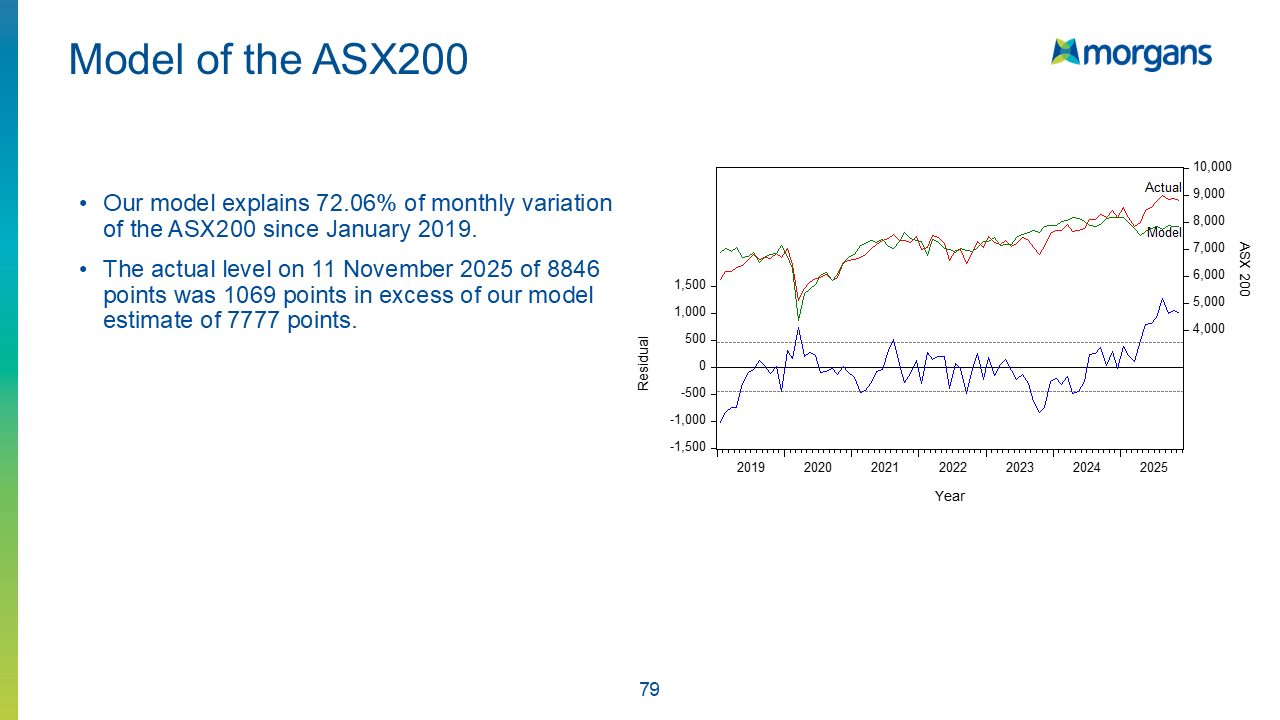
Currency & Bonds
- AUD/USD: Model estimate at US70.94 cents, above current level of US65.48 cents.
- US and German bonds appear moderately overvalued, reflecting strong foreign buying.
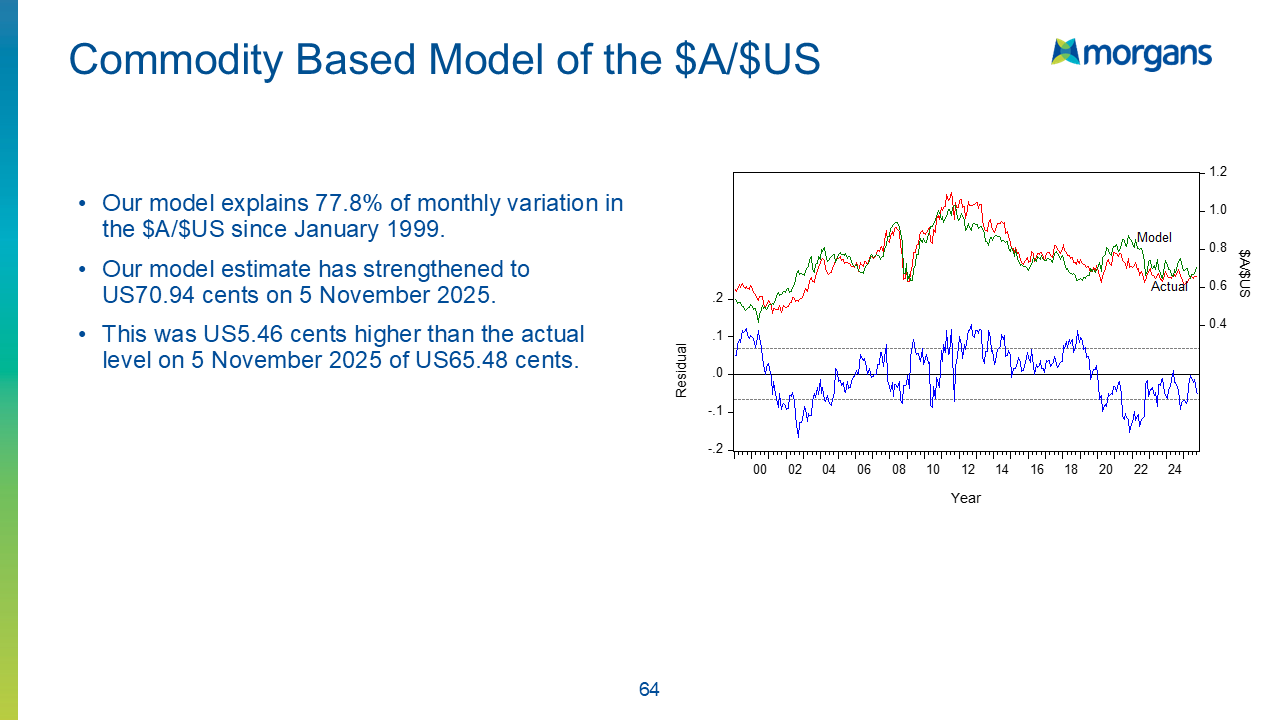
Closing Thoughts
Global growth is slowing, but commodity markets and equities show mixed signals. Inflation pressures in Australia suggest further rate hikes, while US policy may ease. Investors should watch undervalued opportunities in soft commodities and monitor interest rate trends closely.
FAQs
1. What is the outlook for global economic growth in 2025?
Global growth is slowing but stabilising. The US is expected to grow at 1.8%, the Euro Area at 1.2%, China at 4.8%, India at 6.6%, and Australia at 1.9%.
2. Why is Australian inflation expected to remain high?
Inflation pressures are driven by rising retail electricity prices as subsidies end, combined with relatively strong demand and employment trends.
3. Will the Reserve Bank of Australia raise interest rates?
Yes, the RBA cash rate is forecast to rise to around 4.1% in response to higher core inflation.
4. Which commodities are currently undervalued?
Soft commodities like wheat and cotton are significantly undervalued, while iron ore is near fair value and copper remains overvalued.
5. How are equity markets positioned heading into 2026?
The S&P500 is trading below model estimates, suggesting potential upside, while the ASX200 is above fair value, reflecting strong investor sentiment.
DISCLAIMER: Information is of a general nature only. Before making any financial decisions, you should consult with an experienced professional to obtain advice specific to your circumstances.
Why The US Has Higher Productivity
Good morning. Today I want to talk about the U.S. economy in comparison, to other economies and, why it's performing, the way it is. The documents I will refer to are first the IMF, outlook, which is, come out in the last two weeks. That gives us some international comparisons.
For the US economy I use, the monthly outlook from Standard and Poor's, which is, the number one rated by the Congressional Budget Office, well ahead of other economic forecasters. For the US economy, both the IMF and, Standard Poor's agree that growth this year should be 2%. Our own model of the US economy, based on the Chicago Fed National Activity Indicator, is also forcasting US growth of 2%.
Still, that's 2% is less whatever the negative effect is from, from the US shutdown. When the shutdown continues for a month, that growth rate falls from 2% down to about 1.8 % 1.7%. So it's a moderate slowdown. Still growth in the U.S. economy accelerates next year to about 2.2%. I'll talk later on where that growth is coming from.
When we look at growth in other areas we see that: Euro area is miserable. Great Britain is growing faster than the Euro area now. This year the UK should grow by 1.3% but, the Euro area should grow by about 1.2% this year. Euro area growth drifts off to an even more miserable 1.1% next year. But fortunately, that generates a lot of savings to invest in other countries like us. Those savings then go in to the US equities and bond markets and, the Australian stock market and places like that.
China is slowing down to 4.8% this year and 4.2% next year according to the, IMF. Still, heroically India, marches on to 6.6% growth this year and 6.2% next year. For emerging markets, which include the Indo Pacific generally ,Growth is proceeding at about 5.2% this year and 4.7%, next year.
The U.S is still, pretty good in comparison. This year, it's, growing at 2% or, depending on the results of the shutdown. Next US Growth accelerates, to 2.2%, and growth is then about the same the year after.
There's been a lot of debate this year about the effect of tariffs on the US inflation. In spite of higher tariffs , US inflation is stubbornly , stubbornly low. Headline inflation, which includes food and energy this year should be only 2.8%. Hardly something to scare markets. And that continues a 2.9% next year and 2.5% the year after. Amazingly,US core inflation is a bit higher than that 3% this year and 3.3% next year. It's just that food and energy prices are falling in the US. Why can't that happen here?
Lets look at one of the reasons that you get really quite steady growth and relatively low inflation in the US The comparison I want to make here is between US output per hour and Australian output per hour. In the beginning of this year, we had a shocking slowdown in productivity growth because our government decided that was better to hire more, people from the public service than generate employment in the private sector. It is well known that, productivity in the market economy grows much faster than in the, than in the public sector. So, for the first quarter, productivity in Australia grew, or output per hour worked per annum ,grew by 0.3% . The RBA has told us that, they expect output per hour that will rise to about 0.7%per annum , the same as the UK. And we'll be able to maintain productivity growth rate of 0.7%, going forward.
Let's compare that to what's happening in the US economy. This year It looks like the US will be producing labour productivity much higher than the Australia. US Output per hour should grow by 1.6% this year . Next year US Output per hour may grow even more by, 2.1%. Following that US labour productivity the year should grow between 1.6 and 1.7%,. This is full 1% faster than, the Australian economy is expected to grow in terms of productivity. Remember, it's growth and productivity which generates increase in living standards.
There's two reasons, that we can provide for why the U.S., productivity is growing so much faster than ours. One is a flexible labour market. It's an extremely flexible labour market in the US. The current Australian government has made our labour market less flexible, less than it previously was. A second reason is deregulation . The program of deregulation by the US administration is making it easier for business , to do business.
That, of course, in turn generates higher levels of business investment. That higher level of business investments creates more growth. So, it's a series of policies which are different in each country . The result will be that, living standards in, in the U.S are going to start going to be growing significantly faster than they are in Australia.
And that's the end of the good news for the day.









